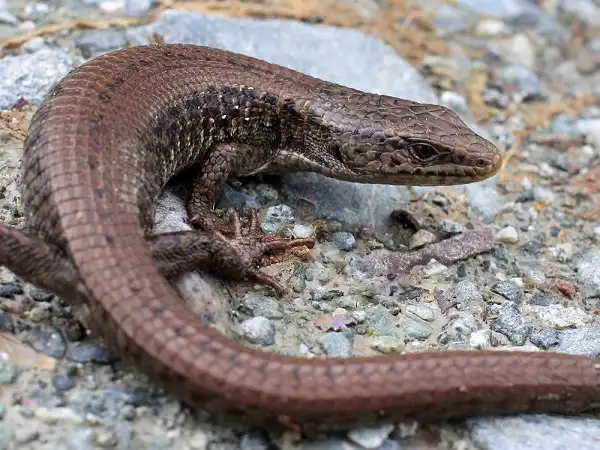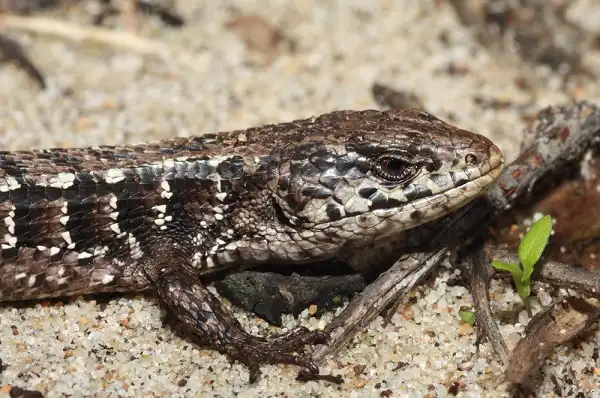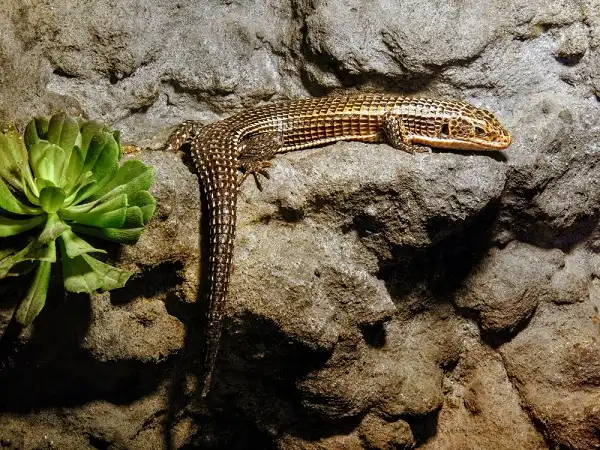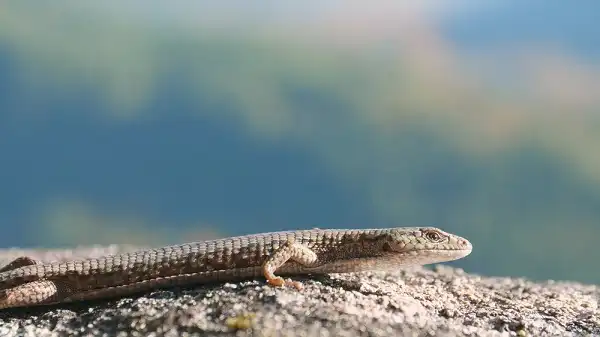The Northern Alligator Lizard is an interesting reptile found in western North America. While not as well known as other lizards from more tropical locations, the distinctive features and habits of this creature make it a fascinating subject of study for herpetologists worldwide. With their striking blue-gray coloration and prominent dorsal ridges along its back, the Northern Alligator Lizard would surely be eye-catching to any observer who crossed its path in its natural habitat. But what’s even more remarkable than its appearance is that despite being found across such a wide geographic range – stretching from Southwestern Canada all the way to Mexico – there are surprisingly few observed variations among its populations across time or region!

Northern Alligator Lizard Description
The Northern Alligator Lizard, scientifically known as Elgaria coerulea, is a reptilian species endemic to western North America. It is distinguished by its captivating blue-gray hue, as well as the pronounced dorsal ridges running the length of its back. Despite its fearsome name, the Northern Alligator Lizard is a placid and docile creature, preferring to retreat into concealment rather than confront perceived threats. Northern Alligator Lizards are quite distinct among lizards. Northern Alligator Lizard has a stout body shape with short limbs and a long tail which helps them move quickly and efficiently when pursuing their prey. They feature a bulging head with small eyes and two prominent rows of spiny scales that run along the top of their neck. Its coloration ranges from bluish-gray to olive green on the back, while its underside is generally yellowish or cream-colored.
Northern Alligator Lizard Habitat
The Northern Alligator Lizard is commonly found in a variety of habitats throughout its vast geographic range. From dense forests to arid deserts, this species has adapted to thrive in a wide range of environmental conditions. In the Pacific Northwest, the Northern Alligator Lizard can be found in moist forests with an abundance of leaf litter and fallen logs. This species prefers areas with moderate sunlight and ample shade, as they are not well-suited to extremely hot or cold temperatures. In the Sierras of California, the Northern Alligator Lizard can be found in boulder fields and rocky outcroppings. Here, they bask in the sun to regulate their body temperature and seek refuge in crevices and small burrows to escape predators and regulate their body temperature during cooler periods. Further south in the chaparral regions of California and Mexico, these lizards can be found in dry, scrubby habitats with sparse vegetation. Despite the aridity of this region, they seek out small pools of water to acquire the moisture they need for survival.
Northern Alligator Lizard Diet
The Northern Alligator Lizard is a small but efficient predator, preying primarily on insects such as beetles, crickets, and grasshoppers. They have also been known to eat spiders and other small animals like mice and other rodents. Unlike some other lizards, the Northern Alligator Lizard is not a fast runner but instead, it relies on its excellent camouflage skills to sneak up on its prey. Interestingly, the Northern Alligator Lizard has a specialized secretion gland in its lower jaw that produces a potent venom to subdue its prey.
This venom is relatively mild, and it is not harmful to humans, but it is effective against small insects and other prey. As ambush predators, these lizards will wait patiently for their prey and then use lightning-fast strikes, aided by their long, sticky tongues, to catch them. In addition to their primary diet of insects, Northern Alligator Lizards have also been known to eat fruits, berries, and flower buds, especially during summertime when these plants are plentiful. This omnivorous adaptation means that the Northern Alligator Lizard can survive in areas where its primary insect prey is scarce.

Northern Alligator Lizard Size
The Northern Alligator Lizard is a small species of lizard, typically measuring between 5 and 8 inches in length. Females tend to be slightly larger than males, with an average length of around 7 inches, while males typically measure around 6 inches in length. Despite their small size, Northern Alligator Lizards are formidable predators, relying on their excellent eyesight and camouflage skills to stalk and capture their prey. They are also equipped with long, slender bodies and long, prehensile tails, which they use to balance and climb through the dense underbrush of their forest and woodland habitats.
Northern Alligator Lizard Lifespan
The Northern Alligator Lizard is a hardy species that is capable of surviving in a range of environments. Like many reptiles, their lifespan is dependent on a variety of factors, including environmental conditions, predation, and disease. In general, Northern Alligator Lizards have a lifespan of around 5-7 years in the wild, although some individuals have been known to live up to 10 years. The Northern Alligator Lizard has several adaptations that help it to survive and thrive in the wild. For example, their rough, scaly skin helps to protect them from predators, while their long, prehensile tails help them to balance and climb through the dense underbrush of their forest habitats. Additionally, their excellent camouflage skills and efficient hunting methods make them highly effective predators, allowing them to obtain the necessary nutrition for optimal growth and development.
Northern Alligator Lizard Behavior
The Northern Alligator Lizard is a highly adaptable and fascinating species of reptile that exhibits a range of interesting behaviors. These behaviors are closely tied to the lizard’s diet, habitat, and reproductive patterns, and offer insights into their complex interrelationships with other organisms and their environment. Another interesting behavior exhibited by the Northern Alligator Lizard is its reproductive strategy. Females typically lay a small clutch of eggs each year, which they carefully bury in a hidden location to protect them from predators. The eggs are then incubated for several weeks, after which the hatchlings emerge ready to fend for themselves. This reproductive strategy helps to ensure the survival of the species in a variety of environments and allows them to rapidly populate suitable habitats.

Northern Alligator Lizard Speed
The Northern Alligator Lizard is renowned for its impressive speed and agility, which allows it to catch prey and evade predators with ease. With their long, slender bodies and powerful tails, these lizards can move quickly and efficiently through dense brush and up trees, all while maintaining remarkable balance and coordination. In fact, the Northern Alligator Lizard is one of the fastest lizards in its range, with an average sprint speed of up to 11 miles per hour. This exceptional speed allows them to outmaneuver and outrun many of their potential predators, including small mammals, birds, and other reptiles. In addition to their impressive sprinting speed, Northern Alligator Lizards are also highly skilled climbers, thanks in part to their prehensile tails and sharp claws. This agility and versatility enable them to navigate their forest and woodland habitats with ease, moving quickly and gracefully through tree branches and underbrush alike.
Northern Alligator Lizard Hunting
Northern Alligator Lizards are well-known for their impressive hunting skills. These reptiles employ a variety of strategies to capture their prey, and their hunting techniques have been honed by millions of years of evolution. When stalking their prey, Northern Alligator Lizards rely on stealth and camouflage to blend in with their surroundings. Their rough, scaly skin helps to protect them from predators and also acts as a form of armor when they are in pursuit of their prey. Their excellent vision is another key factor in their hunting prowess. Northern Alligator Lizards have keen eyesight and are able to pick out their quarry from a distance. They are also able to track their prey by sensing their movements and vibrations.
Their diet mainly consists of insects, but they are also known to consume spiders, small rodents, and other small invertebrates. When hunting, Northern Alligator Lizards use their speed and agility to track and capture their prey. Their long, slender bodies and prehensile tails enable them to climb and maneuver through the dense underbrush of their forest and woodland habitats with ease, allowing them to capture prey both on the ground and in the trees. Another interesting hunting behavior displayed by Northern Alligator Lizards is their use of ambush tactics. They will often hide and wait for their prey to come into range before striking. This technique is particularly effective when they are hunting insects or other small invertebrates.

Conclusion
The Northern Alligator Lizard is a remarkable species that has evolved a variety of impressive physical and behavioral adaptations. Their speed and agility, powerful muscles, and prehensile tails enable them to move quickly through their forest and woodland habitats. Additionally, their keen vision and hunting skills make them formidable predators within their environment. By studying the behavior of these reptiles, researchers can gain important insights into relationships between different species and the intricate workings of the natural world. The knowledge gained from researching the Northern Alligator Lizard could further contribute to our understanding of evolution, ecology, biology, conservation, and other related fields.
Frequently Asked Question

